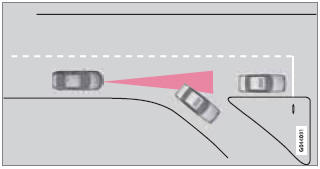 Volvo XC60: Queue Assist
Volvo XC60: Queue Assist
The following functions are linked to your vehicle's automatic transmission and comprise the Queue Assist feature.
Please note that the lowest speed that can be set is 18 mph (30 km/h), although ACC can maintain a set speed/distance to a vehicle ahead down to a standstill. Queue Assist consists of the following features:
Enhanced speed interval
Your vehicle can maintain the set time interval to the vehicle ahead at any permissible speed, including a complete stop.
In order to activate ACC at speeds below 18 mph (30 km/h):
• The vehicle ahead must be within a reasonable
distance (not farther away than
approx. 100 ft/30 meters)
• The lowest speed that can be selected is
18 mph (30 km/h), although ACC will also
help maintain the set time interval to the
vehicle ahead at lower speeds, including a
complete stop.
During short stops (less than approximately 3 seconds) in slow-moving traffic, your vehicle will begin moving again automatically as soon as the vehicle ahead begins to move.
If it takes more than 3 seconds for the vehicle ahead to begin moving, ACC will be automatically go into standby mode.
The driver will then have to reactivate ACC in
one of the following ways:
• By pressing 
• By accelerating up to at least 3 mph
(4 km/h)
Your vehicle will then resume following the vehicle ahead at the set time interval.
NOTE
ACC can remain active and keep your vehicle
at a standstill for up to 2 minutes. After
2 minutes have elapsed, the parking brake
will be engaged and ACC will go into
standby mode.
To reactivate ACC, the driver must release
the parking brake (see page 123) and press
 .
.
Automatic standby mode when ACC changes target vehicles

If the vehicle ahead turns suddenly, there may be
a stationary vehicle ahead
The following only applies at speeds below approximately 18 mph (30 km/h):
If ACC changes target vehicles (the vehicle that the radar sensor has detected) from a moving vehicle to a stationary one, the system will apply the brakes in your vehicle.
WARNING
At speeds above 18 mph (30 km/h), ACC
will not react to a stationary vehicle and
apply the brakes but will instead accelerate
to the previously set speed. The driver must
actively apply the brakes to stop the vehicle.
ACC disengages and goes into standby mode if:
• Your vehicle's speed goes below 10 mph (15 km/h) and ACC cannot determine if the target object is a stationary vehicle or some other type of object such as e.g., a speed bump.
• Your vehicle's speed goes below 10 mph (15 km/h) and the vehicle ahead turns so that ACC no longer has a target vehicle to follow.
No automatic braking when at a standstill
In certain situations, ACC will no longer apply the brakes and go into standby mode while the vehicle is not moving. This means that the driver will have to apply the brakes.
This happens if:
• The driver presses the brake pedal
• The parking brake is activated
• The gear selected is moved to P,N or R
• The driver presses the  button to
put ACC in standby mode
button to
put ACC in standby mode
The parking brake is applied automatically
In certain situations, ACC will apply the parking brake in order to continue keeping the vehicle at a standstill.
This happens if:
• The driver opens the door or takes off his/her seat belt
• DSTC is put in Sport mode (see page 149)
• ACC has kept the vehicle at a standstill for more than 2 minutes
• The engine has been switched off
• The brakes have overheated
 Automatic standby mode
Automatic standby mode
Adaptive cruise control is linked to other systems
such as the stability and traction control
system (DSTC). If this system is not functioning
properly, adaptive cruise control is automatically ...
 Turning ACC off completely
Turning ACC off completely
• From standby mode, press once.
• From active mode, press twice.
The set speed and time interval are then
cleared from the system's memory and cannot
be resumed by pressing . ...
See also:
Folding back the mirrors
Push backward to fold the mirrors.
■When the mirrors are fogged up (vehicles with outside rear view mirror
defoggers)
Turn on the mirror defoggers to defog the mirrors.
CAUTION
■Whe ...
Emergency towing
If a tow truck is not available, in an emergency your vehicle may be
temporarily towed using a cable or chain secured to the emergency
towing eyelet. This should only be attempted on hard surfaced r ...
Installing the spare tire
The spare tire is designed for emergency
use. (See specific instructions under the
heading “Wheels and tires” in the “8.
Maintenance and do-it-yourself” section.)
1. Clean any mud or d ...
